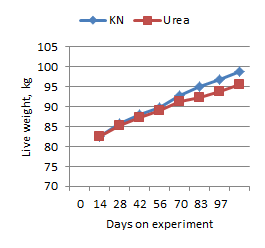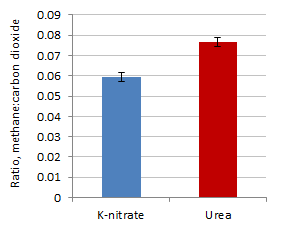Effect of potassium nitrate and urea on growth performance and methane emissions in "Yellow" cattle fed lime-treated rice straw supplemented with fresh cassava foliage
Sangkhom Inthapanya, Duong Nguyen Khang* and T R Preston**
Souphanouvong University, Lao PDR
inthapanyasangkhom@yahoo.com
*Department
of Animal Physiology and Biochemistry, Nong Lam University,
Ho Chi Minh City, Vietnam
**Finca Ecológica TOSOLY, AA48 Socorro, Santander, Colombia
Abstract
The aim of this study was to evaluate the effect of combining alkali treatment of rice straw with non-protein nitrogen (NPN) from nitrate in reducing methane production in an in vitro incubation system. The treatments in a split-plot 2*6 arrangement with four replications were: alkali treated straw with NaOH (0; 1; 2; 3; 4%) plus lime (Ca(OH)2) (4; 3; 2; 1; 0%) or untreated straw, and as NPN source potassium nitrate or urea. All treatments had fresh cassava leaf as protein source. The quantity of substrate was 12g to which were added 240 ml rumen fluids (from slaughtered buffalo) and 960 ml of buffer solution. The incubation was for 24h with measurements of total gas production, methane percentage at intervals of 4; 8; 12; 16 and 24 hours and determination of residual unfermented substrate at the end.
The proportion of substrate fermented after 24h was increased by alkali treatment and tended to increase as lime replaced NaOH (Figure 1). Total gas production and methane percentage increased with incubation time and were reduced when nitrate replaced urea at all fermentation stages. After 24h, the methane production per unit of fermented substrate was less when nitrate replaced urea (Figure 2). It is concluded that lime can replace NaOH as a means of increasing the fermentability of rice straw and that methane production is decreased with potassium nitrate as NPN source.
 |
 |
|
Figure 1. Growth curves of "Yellow" cattle fed lime-treated rice straw and cassava foliage with K-nitrate or urea as NPN source |
Figure 2. Live weight gain of "Yellow" cattle fed lime-treated rice straw and cassava foliage with K-nitrate or urea as NPN source |
 |
 |
|
Figure 3. DM feed conversion of "Yellow" cattle fed lime-treated rice straw and cassava foliage with K-nitrate or urea as NPN source |
Figure 4. Ratio of methane to carbon dioxide in expired breath of "Yellow" cattle fed lime-treated rice straw and cassava foliage with K-nitrate or urea as NPN source |